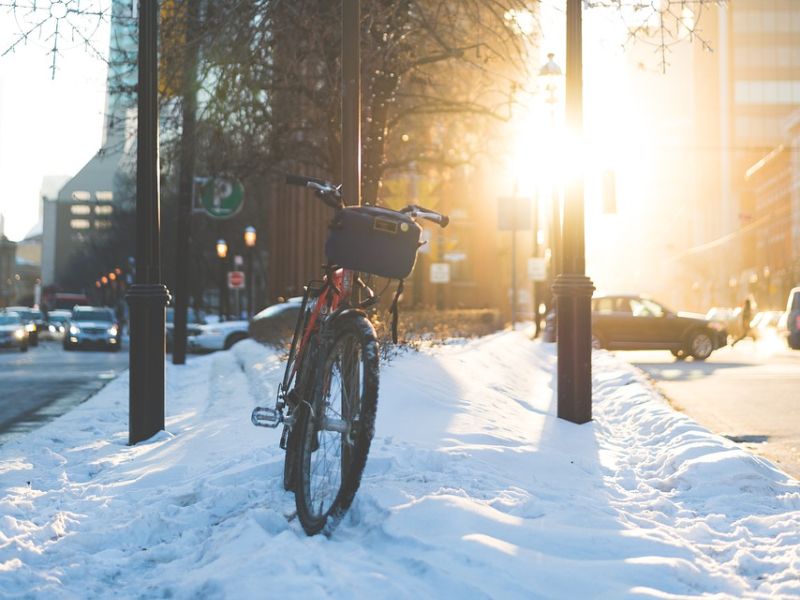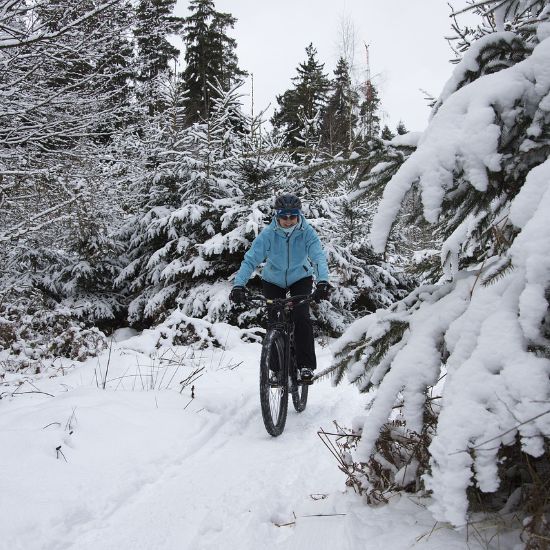
Cycling on bright and cold mornings as the sun rises over frosted grass and the fog lifts from the landscape is why we love cycling in the winter so much. But for many, when the winter months come the bike is put away until spring comes, which is such as shame.
Wearing the right winter cycling gear and planning a trip to the best winter cycling destinations will make you fall in love with riding at this time of year. Here’s all you need to know to stay warm and safe to cycle in winter.
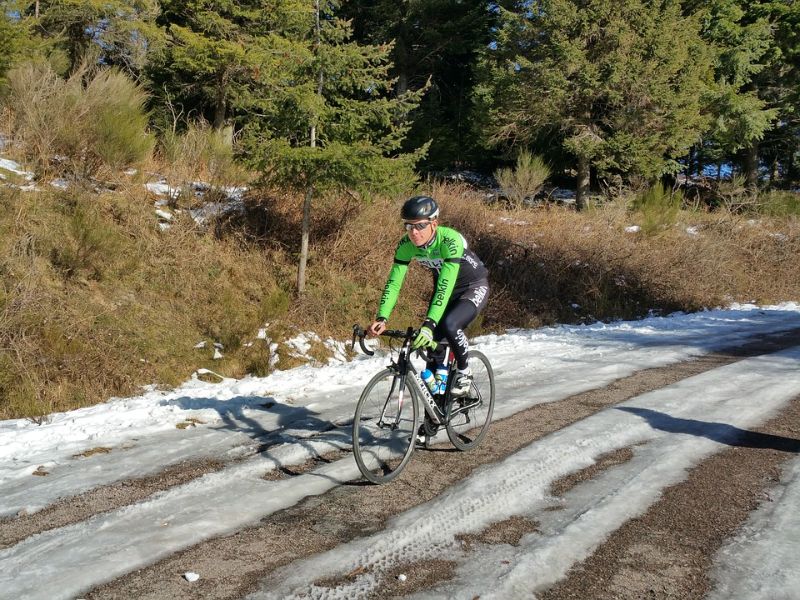
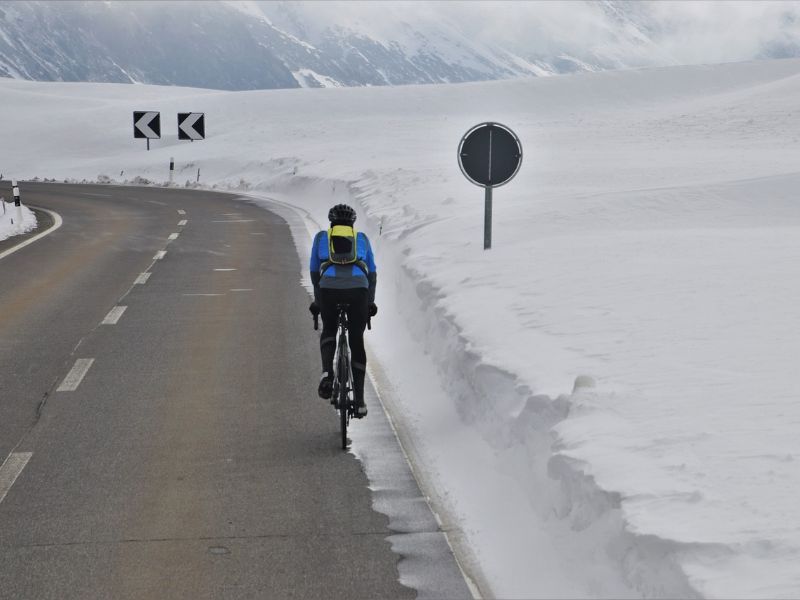
The basics are pretty much the same as the clothes you need for cycling in autumn. A base layer is the layer of clothing that is in direct contact with your skin and usually comes in the form of a long-sleeved top and full-length leggings, they’re an essential part of your winter cycling wardrobe. The success or failure of your winter-weather cycling gear often depends on the materials you choose.
Natural materials like merino wool are a very popular choice for many reasons. Merino wool wicks moisture away which is vitally important, if moisture stays on your skin and cools, you’ll feel the chill. The material is also odour-resistant, durable, and comfortable, which can make all the difference on multi-day bikepacking trips to the best gravel bike winter destinations.

Synthetic materials like polyester do most of what merino wool does, but not quite as well in most cases. The main benefit of synthetic base layers is price. They’re often available at a fraction of the price of merino wool while still doing a good job at keeping you warm.
When you’re figuring out what to wear cycling in winter, it’s vital that you don’t overlook the mid-layer. This is the layer that cyclists wear on top of the base layer to provide the right amount of insulation.
It’s important to consider your climate when buying winter cycling gear so that you’re not too cold or even too hot when riding your bike. If you live in parts of the world with freezing cold temperatures then high levels of insulation are needed, but if you live in warmer climates, then finding the right balance of warmth and breathability should be the main focus.

Again, materials play a big part in finding the right mid-layer for you. The two most popular choices are fleece or down.
Down is a natural material, and much like merino wool, it’s the premium option. Down is the best choice if your main concern is warmth as the feathers lock in heat to keep you toasty on winter cycles. Durability and longevity also play a part, as down mid-layers can be repaired, they hold their shape, and don’t pile like fleece mid-layers do. As a natural material, down also has less of an impact on the environment when compared to manufacturing synthetic materials that create microplastics.
However, synthetic materials like fleece also have some benefits that are well worth considering. A fleece mid-layer is quite likely to be a lot cheaper than a down one, which can be the deciding factor for a lot of us cyclists. Fleece is also quite light, has better moisture-wicking than down and is even slightly more breathable.
Winter cycling jerseys take a standard jersey and add an extra layer of insulation to an already proven piece of cycling kit. If you’re looking for even more warmth from your mid-layer, try a gilet. This sleeveless jacket focuses on keeping your core warm on cold winter days and when spring comes around, you can wear your gilet as your outer layer.
Your outer layer is your first line of defence against the elements. While base layers and mid-layers are all about keeping you warm, your outer layer is focused on keeping you dry.
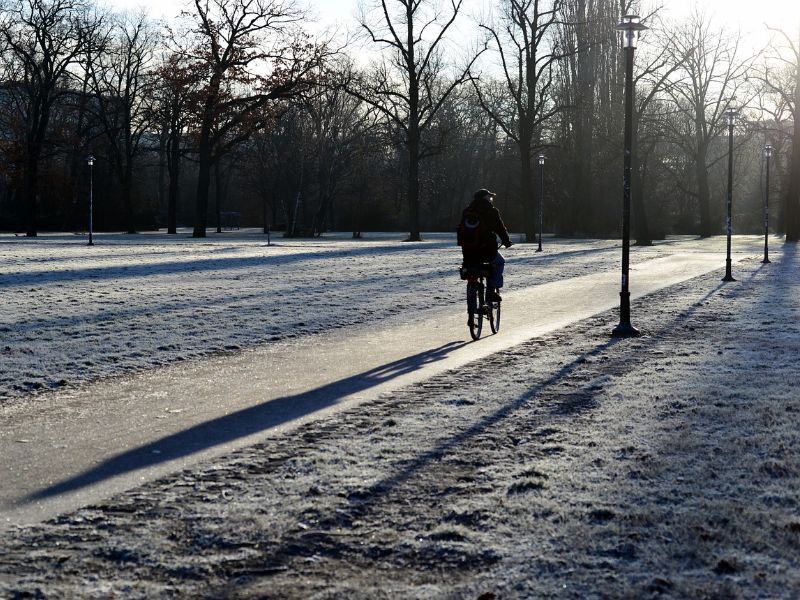
Some parts of the world are much wetter than others, so we suggest trying to find an outer layer with the right amount of waterproofness for your area. A wet cyclist quickly becomes a cold and very unhappy one, which is why a good quality waterproof cycling jacket is essential.
It’s not just moisture from rain that we have to worry about though, we need to make sure the moisture from sweating has a way to escape. If your outer layer isn’t breathable then that moisture can’t escape and will give you a chill. Staying dry allows you to stay warm.
Waterproof jackets come with a waterproof rating, often you’ll see these range from 5,000mm to 20,000mm. The higher the mm rating, the better the level of waterproofness. So you should always pick the higher number, right? Not quite. To block out moisture jackets can also prevent moisture escaping, that’s why it’s important to look at the breathability rating too. This ranges from 5,000 to 20,000g/m² with the very best winter cycling jackets having a high rating in both.
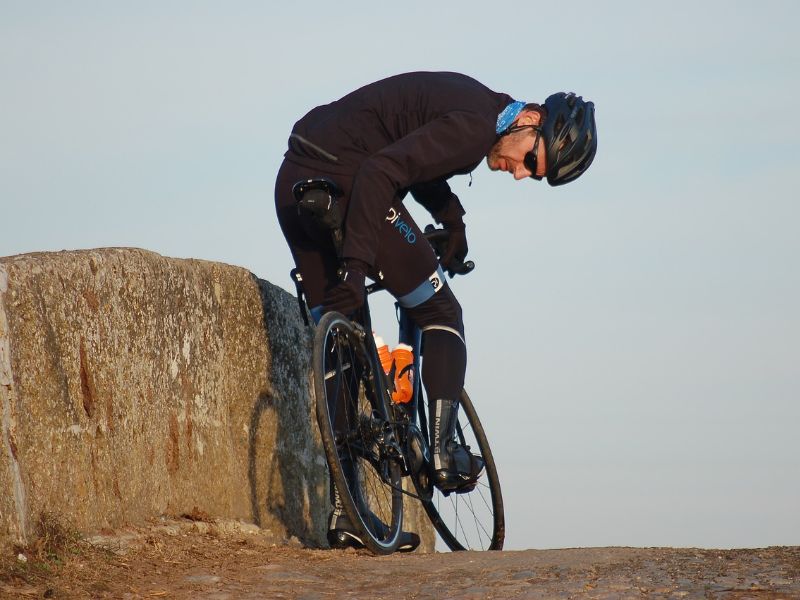
That’s the upper body taken care of, but our legs are still exposed. Warm legs mean our muscles can perform better on winter rides so we can keep training regardless of the weather. Winter bib tights are longer than regular ones, with most starting below the calf. They focus on providing great levels of thermal insulation and some can be found with a water-repellent finish.
Winter can be one of the most challenging and rewarding times to go mountain biking. You’ll vastly improve your bike handling skills in the wet, get better and controlling your body weight in slippery conditions, and experience the trails in a whole new way. But it can be hard to get motivated if you know you’ll be soaking wet and freezing cold. Try an MTB onesie or mono-suit that offers full body protection from the wind and rain. If paired with quality base layers, you’ll be shredding trails at one of the best winter MTB destinations while being toasty warm.
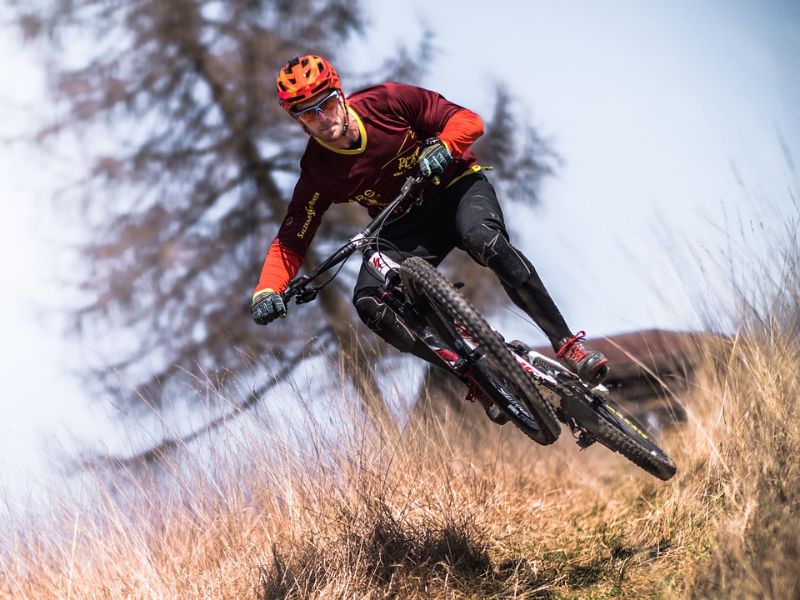
Small details can make all the difference when out on your bike in winter. Winter-specific accessories are hugely popular and cover every aspect of cycling. Here are some of our top recommendations.
Mountain bikers who ride enduro trails need to pick up a pair of goggles for winter bike rides. Rain can turn the trails into mud pits which get sprayed everywhere when you ride through them. It’s a given that you’re going to get mucky in this situation, but one place you definitely don’t want mud is in your eyes. A pair of goggles keeps your eyes mud-free and focused on the trail ahead.
Cycling in winter clothing not only keeps you warm but keeps you safe too. Road, gravel, and XC riders should pick up a pair of clear glasses for the very same reasons. Water spray from the road can be a disaster at high speeds and the clear lens gives you great low-light visibility. Not all winter days are dark and dreary though, expect some sunny days that require a tinted pair of glasses.
No winter cyclist leaves the house without a pair of winter cycling gloves on. These are absolutely vital to staying warm and happy on the bike as the wind chill in winter can be brutal. There are two main things to consider – warmth and waterproofness. Both add bulk which isn’t ideal, but if you run cold then it can be well worth the trade-off.
Another part of the body that can get very cold in winter is your feet. Thankfully, there are socks and shoes designed specifically for winter cycling. Waterproof and insulated socks can fight off rainy winter days and keep your toes warm. Waterproof winter cycling shoes are a rugged choice that helps keep moisture out with waterproof linings and winter-specific features like insulation, wide lugs for walking grip in the mud, and higher cuffs to keep water out.
A neck warmer blocks out nasty winds as you cycle and gives an extra layer of comfort and cosiness. A tube-style neck warmer can be pulled up over your ears on very cold days for even more coverage, keeping your skin protected. Thin hats that sit between your head and helmet are another smart choice for winter rides as helmets are designed for maximum ventilation, but in winter this can make things chilly.
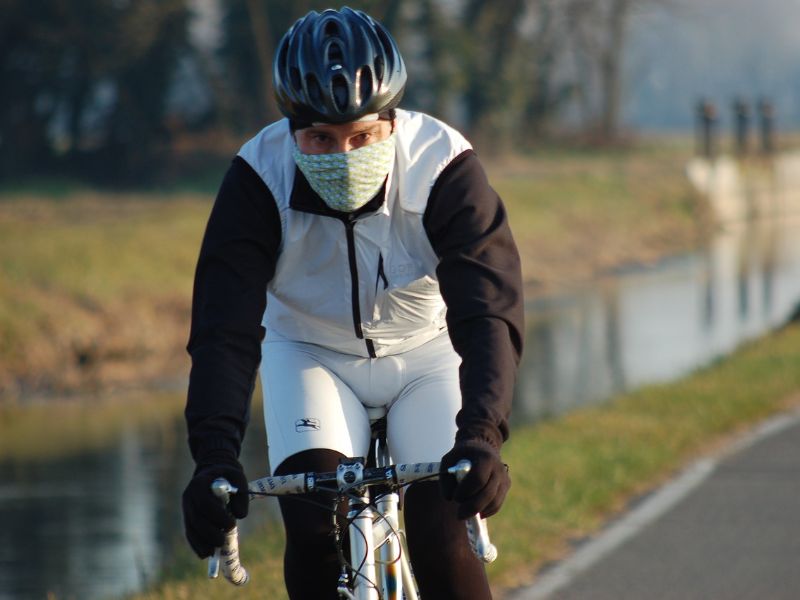
When it comes to cycling in winter, it’s important to make sure that your bike is prepared for the colder weather too. Small changes can help keep you safe as well as comfortable.
Mudguards are essential for all winter bikes. Attach one to the front of your bike to prevent water spray from the roads or mud from the trails from getting into your eyes. On the rear, a mudguard can help keep your clothes dry and clean.
If you don’t want to add too much weight to your bike, you can opt for a small ass saver, which is a minimalist folding mudguard.
Stay safe and be seen with lights on your bike. Bike lights are generally designed to do one of two things. Lights that help you to see act as headlamps on a car and light up the trail or road in front of you. These are great for night-time mountain bike rides and commutes to work in the pitch dark. The other type of light helps you be seen by others. These lights often flash and can be very noticeable even during daylight hours.
Cleaning your bike after muddy winter cycles is important. All that dirt and debris can clog up your drivetrain, damage brake pads and affect your suspension if not washed away. A quick hose down with water and a bike cleaner will have your bike looking and performing great. Try using a chain lube that’s designed specifically for wet weather conditions to ensure smooth shifting.
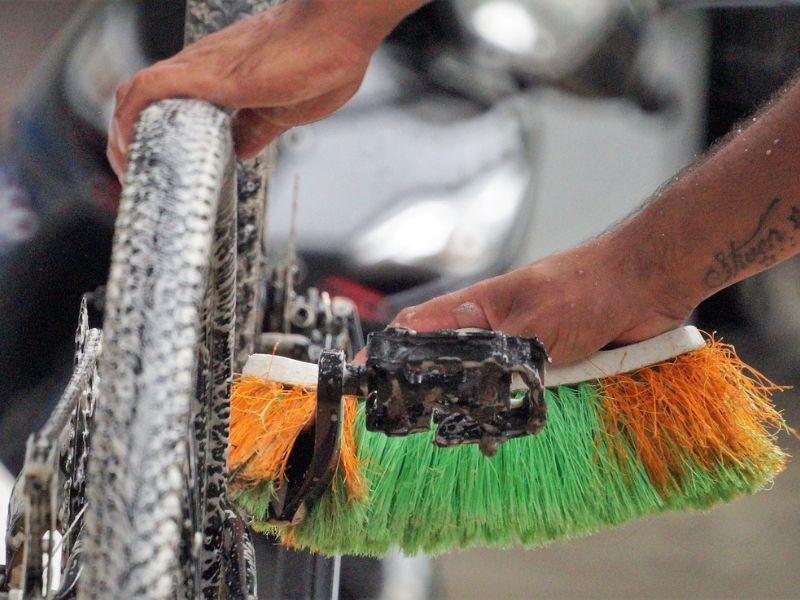
Cycling in winter has so many great benefits; the trails are much quieter, the scenery is picturesque, and you can keep fit while others aren’t training. We think winter is also a great season to mix things up with a bike rental and try something new.
Winter is a brilliant time to try gravel biking. You’re out in the wilderness, completely surrounded by nature, and exploring brilliant gravel roads that take you to some stunning places. Be inspired by our selection of the best winter gravel destinations. There are lots of gravel bikes for rent on ListNRide, giving you the choice to find the right build and location that suits you.
The colder months are also a fantastic time to work on your bike and make some upgrades ahead of the warmer months and group rides. By renting it with your ideal specification, you can try a bike before you buy to see if it’s worth splurging on that new mountain bike fork or fancy drivetrain.
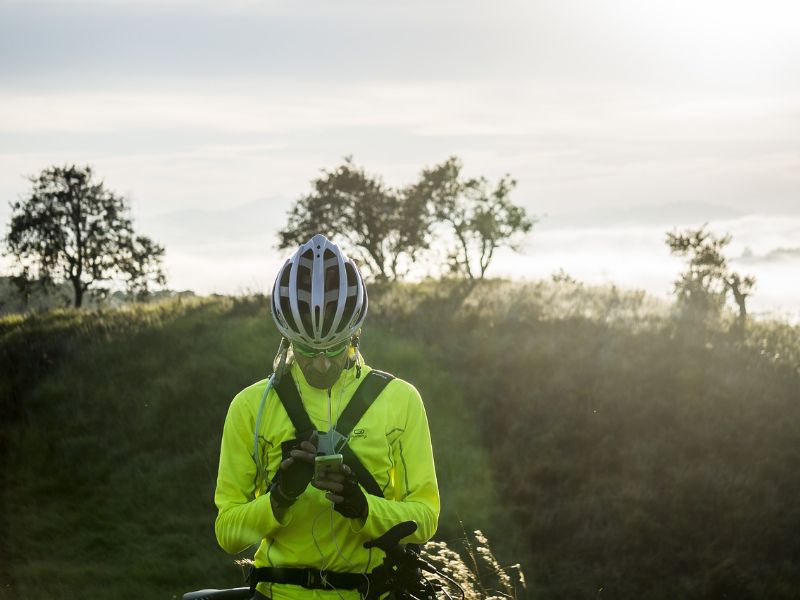
We love cycling in winter, and if you ask us, the best cities to visit on a bike in winter get even better when they’re covered in a blanket of snow. Picture yourself cruising through the historic streets of a bustling capital city on an e-bike, cycling from tourist attraction to cute café as you please. With a bike rental from us, you can just turn up, find a bike you like and get going – it’s as simple as that!
There’s just one thing standing between you and winter cycles through a snowy landscape and that’s having the right winter cycling clothing. Plan ahead, know what materials and items you need, and you’ll soon see why experienced cyclists love this time of year.
Not ready to winterproof your bike, but want to experience winter cycling anyway? Sign up for ListNRide and rent a bike for your next winter riding adventure. Stay safe and stay warm out there!
